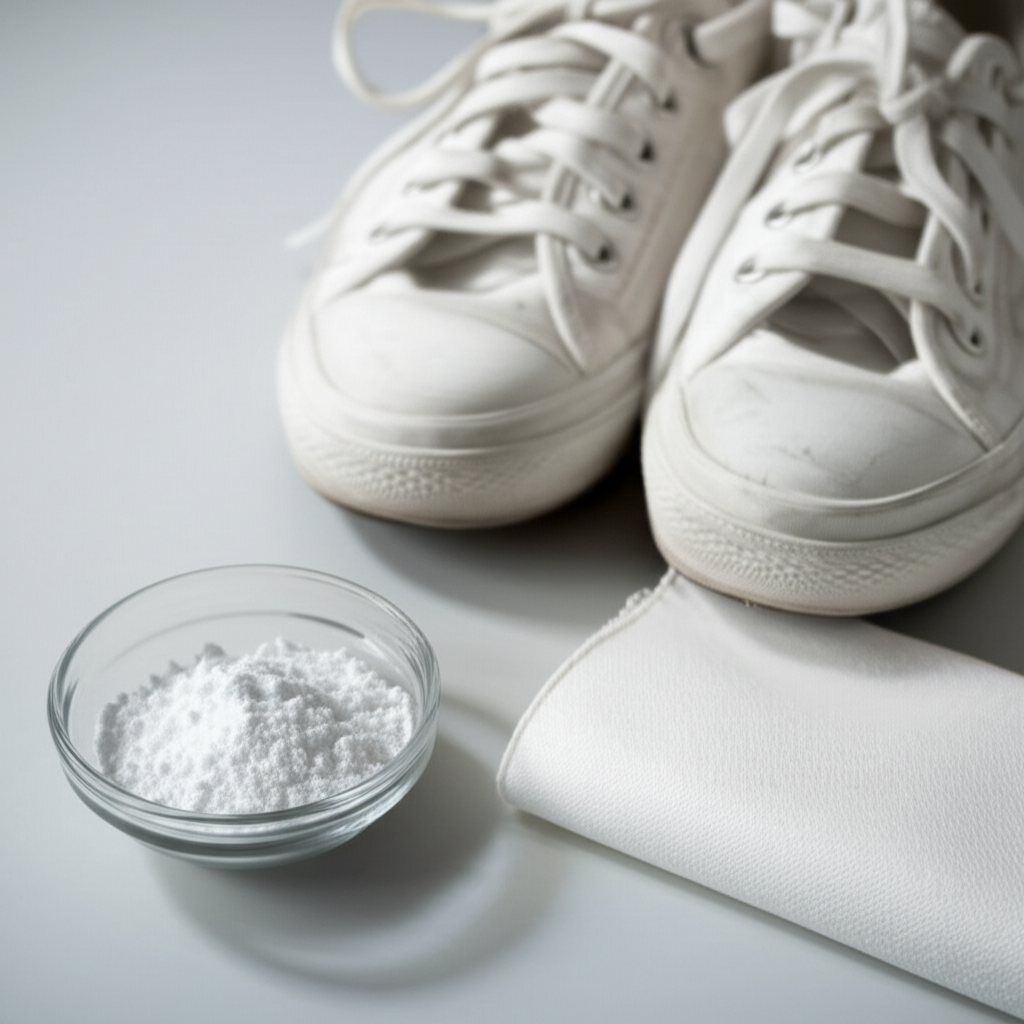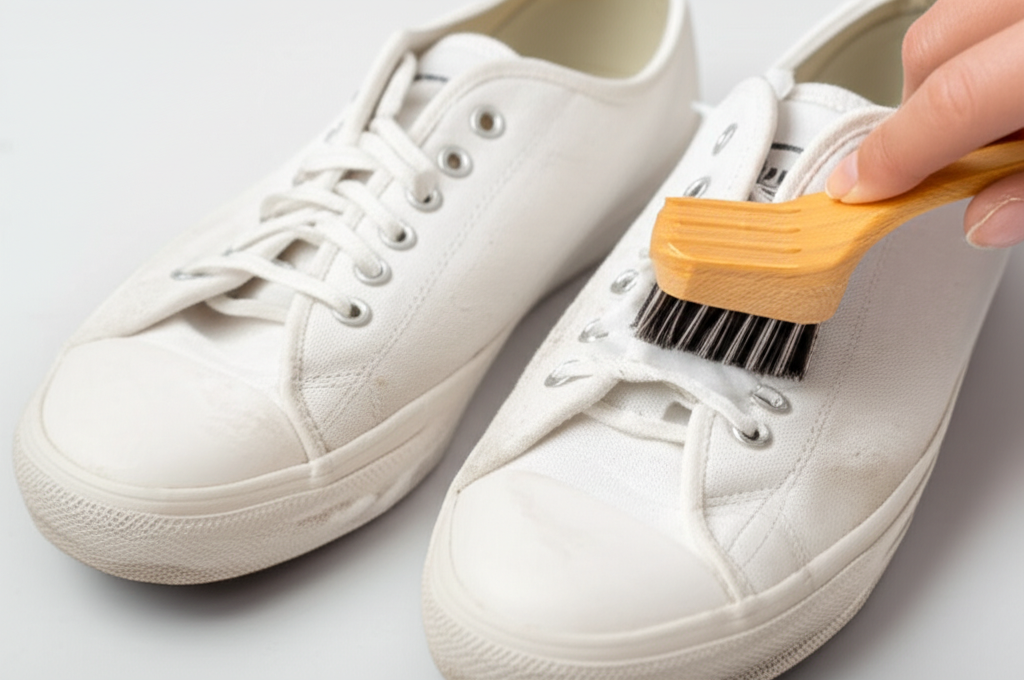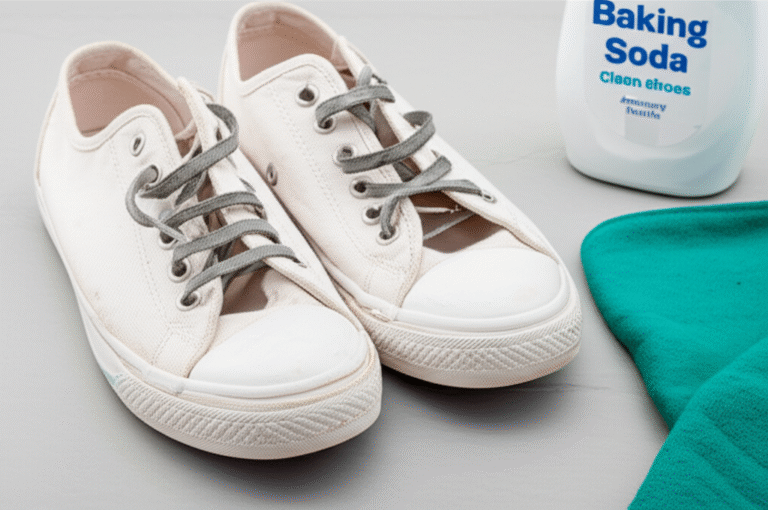Yes, baking soda can effectively clean shoes, especially when dealing with odors and light stains. Its abrasive yet gentle nature makes it a surprisingly powerful, natural cleaning agent for various shoe materials, offering amazing results for freshness and a brighter appearance without harsh chemicals.
Key Takeaways
- Baking soda deodorizes shoes effectively.
- It gently scrubs away light dirt and stains.
- It’s a natural, affordable cleaning solution.
- Test on an inconspicuous area first.
- Avoid excessive moisture with baking soda pastes.
- Best for fabric, canvas, and rubber soles.
Does Baking Soda Clean Shoes? Amazing Results!
We all love our shoes, but keeping them looking and smelling fresh can be a challenge. From gym sneakers to casual loafers, dirt, scuffs, and stubborn odors can quickly diminish their appeal. You might be wondering if there’s a simple, natural solution hiding in your kitchen pantry. Does baking soda clean shoes? The answer is a resounding yes! This humble household staple is a secret weapon for many shoe enthusiasts and everyday wearers alike. It’s an affordable, accessible, and surprisingly effective way to tackle common shoe cleaning woes. Get ready to discover how this powdery wonder can bring your footwear back to life, leaving them cleaner and odor-free.
Understanding Baking Soda’s Cleaning Power

Baking soda, scientifically known as sodium bicarbonate, is a mild alkali. This chemical property is key to its cleaning prowess. When mixed with water, it can neutralize acids, which are often the source of unpleasant odors. Think of it as a gentle but persistent cleaner that can break down grime and neutralize odor-causing molecules without being overly harsh on many shoe materials. Its fine, granular texture also provides a light abrasive action, helping to scrub away surface dirt and stains without scratching or damaging most common shoe fabrics.
The science is simple: baking soda is a natural deodorizer because it absorbs and neutralizes odor molecules rather than just masking them. Odors in shoes are often caused by bacteria that thrive in moist environments, breaking down sweat and releasing smelly compounds. Baking soda’s alkaline nature interferes with these acidic compounds, making them less volatile and therefore less noticeable. For cleaning, its mild alkalinity can help lift dirt and grime from surfaces. When used as a paste, it can create a gentle scrubbing action that loosens stains.
Why Choose Baking Soda for Shoe Cleaning?
In a world filled with specialized shoe cleaners, why turn to baking soda? The reasons are compelling, especially for those new to shoe care or looking for budget-friendly options.
Affordability and Accessibility
Baking soda is one of the most inexpensive cleaning agents available. A box costs mere dollars and can last for many cleaning sessions. It’s readily available in almost every grocery store, making it incredibly convenient to pick up whenever you need it.
Natural and Eco-Friendly
For those concerned about harsh chemicals, baking soda is a fantastic natural alternative. It’s non-toxic, biodegradable, and safe to use around children and pets (when handled appropriately, of course). You can feel good knowing you’re not introducing harmful substances into your home or the environment.
Versatility
While we’re focusing on shoes, baking soda is a multi-purpose cleaner for countless household tasks. This means the box you buy for your sneakers can also help clean your sink, freshen your carpets, and even act as a gentle leavening agent in baking!
Effectiveness on Odors
This is where baking soda truly shines. If your primary concern is shoe odor, baking soda is one of the best natural solutions. It doesn’t just cover up smells; it actively absorbs and neutralizes them, leaving your shoes smelling genuinely fresh.
What Types of Shoes Can Baking Soda Clean?

Baking soda is a versatile cleaner, but its suitability can vary depending on the shoe material. It’s generally best for shoes with fabric, canvas, mesh, or rubber components. Always remember to test any cleaning method on a small, inconspicuous area first to ensure it doesn’t cause discoloration or damage.
Canvas and Fabric Shoes
This is where baking soda often shows its most impressive results. Sneakers, espadrilles, and other fabric-based shoes can benefit greatly from baking soda’s cleaning power. It can lift dirt from the weave and help remove those common scuffs and marks.
Mesh Sneakers
The porous nature of mesh can trap dirt and odors. Baking soda, especially as a paste, can work its way into the mesh fibers to loosen grime and absorb smells. Just be gentle to avoid snagging the material.
Rubber Soles and Midsoles
The white rubber parts of your shoes often get the dirtiest. Baking soda paste is excellent for scrubbing these areas clean, restoring their bright white appearance without harsh bleaches.
Leather Shoes (with Caution)
For smooth leather, baking soda can be used very sparingly and carefully as a paste to tackle specific stains. However, it can be drying. Always follow up with a leather conditioner. For suede or nubuck, it’s best to avoid baking soda altogether, as it can damage the delicate nap.
Suede and Nubuck Shoes (Generally Avoid)
The fine particles of baking soda can be too abrasive for the delicate nap of suede and nubuck. While some online guides might suggest it for light scuffs, the risk of damaging the material is high. It’s better to use specialized suede brushes and cleaners for these materials.
How to Use Baking Soda to Clean Shoes: Step-by-Step Guide
Ready to put baking soda to the test? Here’s a comprehensive guide for cleaning different aspects of your shoes.
Method 1: For General Cleaning and Brightening (Canvas/Fabric/Mesh)
This method is great for refreshing the overall look of your fabric shoes and tackling light dirt.
What You’ll Need:
- Baking soda
- Water
- A small bowl
- A soft brush (an old toothbrush works well)
- A clean cloth
- Optional: White vinegar (for tougher stains or odor boosting)
Steps:
- Prepare the Paste: In the small bowl, mix about 1 tablespoon of baking soda with just enough water to form a thick paste. Aim for a consistency similar to toothpaste.
- Apply the Paste: Using your fingers or the brush, apply the paste directly to the dirty areas of your shoes. Gently rub it into the fabric with the brush, paying attention to stained spots. For very dirty shoes, you can apply the paste all over the uppers.
- Let it Sit: Allow the paste to sit on the shoes for about 10-15 minutes. This gives the baking soda time to work on loosening the dirt and neutralizing any odors.
- Scrub Gently: Use your soft brush to gently scrub the paste into the fabric. Work in small, circular motions. Be firm but gentle to avoid damaging the material.
- Wipe Clean: Dampen a clean cloth with water and wipe away the baking soda paste. You may need to rinse the cloth multiple times to remove all residue.
- Rinse (Optional but Recommended): For a more thorough clean, you can lightly rinse the shoes under cool running water. Avoid soaking the shoes, as excessive moisture can damage adhesives and affect the shape. If rinsing, ensure you get all the baking soda out.
- Dry Naturally: Stuff the shoes with paper towels or clean rags to help them retain their shape and absorb excess moisture. Let them air dry completely away from direct heat or sunlight. Never put shoes in a clothes dryer, as the heat can cause damage.
Method 2: Tackling Tough Stains and Scuffs
For more stubborn marks, a slightly different approach can be more effective.
What You’ll Need:
- Baking soda
- Hydrogen peroxide (3% solution – available at pharmacies)
- A small bowl
- A soft brush
- A clean cloth
Steps:
- Mix the Stain Fighter: In the bowl, combine 1 tablespoon of baking soda with 1 tablespoon of hydrogen peroxide. Mix until you get a paste. Hydrogen peroxide has mild bleaching properties that can help lift stains.
- Spot Treat: Apply the paste directly to the stain or scuff mark using your brush.
- Let it Work: Allow the paste to sit on the stain for about 10-20 minutes. You might see a slight fizzing action, which is normal.
- Gently Scrub: Use the brush to gently scrub the area.
- Wipe Away: Dampen a clean cloth with water and wipe away the paste. Rinse the cloth frequently.
- Air Dry: Allow the shoes to air dry completely.
Important Note: Hydrogen peroxide can lighten some colored fabrics. Always test this mixture on an inconspicuous spot first!
Method 3: Deodorizing Shoes
This is perhaps the easiest and most popular use for baking soda in shoe care.
What You’ll Need:
- Baking soda
- An old sock, cheesecloth, or a small breathable bag (like a sachet bag)
Steps:
- Fill the Container: Pour about 1-2 tablespoons of baking soda into an old sock or a small breathable bag. Tie it securely or close the bag.
- Insert into Shoes: Place the filled sock or bag inside each shoe. Make sure it reaches into the toe area.
- Let it Work Overnight: Leave the baking soda in the shoes overnight, or for at least several hours. The baking soda will absorb moisture and neutralize odors.
- Remove and Wear: Remove the sock/bag before wearing your shoes. You can reuse the baking soda for a few days before replacing it with fresh baking soda.
Alternative Deodorizing Method: You can also sprinkle a thin layer of dry baking soda directly into the shoes, leave it overnight, and then thoroughly shake or vacuum it out in the morning.
Cleaning Specific Shoe Parts with Baking Soda
Let’s break down how to use baking soda on the most common shoe components.
Cleaning White Rubber Soles and Midsoles
The white rubber on sneakers is notorious for picking up dirt and scuffs. Baking soda is a perfect gentle abrasive for this.
What You’ll Need:
- Baking soda
- Water
- A small bowl
- An old toothbrush or a magic eraser
Steps:
- Make a Paste: Mix baking soda with a little water to form a thick paste.
- Apply and Scrub: Apply the paste to the rubber soles and midsoles. Use the toothbrush to scrub the paste into the rubber, focusing on dirty areas and scuffs. For stubborn marks, a magic eraser (which is essentially a melamine foam, a micro-abrasive) can be used after applying the paste, but be gentle.
- Wipe Clean: Wipe away the paste with a damp cloth.
- Rinse if Needed: A quick rinse under cool water can help remove any residue.
- Dry: Let them air dry.
This method can significantly brighten up those dingy white soles, making your entire shoe look cleaner.
Cleaning Laces
Shoelaces often get just as dirty as the rest of the shoe. Baking soda can help!
What You’ll Need:
- Baking soda
- Warm water
- A small bowl or sink
- An old toothbrush
Steps:
- Soak: Remove the laces from your shoes. Place them in a bowl or sink and cover them with warm water. Add a tablespoon of baking soda and mix well.
- Scrub: Let them soak for about 30 minutes. Then, use an old toothbrush to scrub away dirt and grime.
- Rinse: Rinse the laces thoroughly under cold water until all baking soda is gone.
- Dry: Lay them flat or hang them to air dry completely before re-lacing your shoes.
Pro Tips for Using Baking Soda on Shoes
Maximize your cleaning efforts with these expert tips.
- Always Test First: Before applying any baking soda mixture to your entire shoe, test it on a small, hidden area (like the inside of the tongue or near a seam) to ensure it doesn’t cause discoloration or damage.
- Don’t Over-Soak: While rinsing is good, avoid fully submerging or soaking shoes unless they are specifically designed for it (like some canvas sneakers). Excessive moisture can break down adhesives and warp shoe materials.
- Patience is Key: For tougher stains or deeply ingrained odors, you might need to repeat the process or let the baking soda sit for longer.
- Ventilation Matters: When cleaning shoes, especially with pastes, do so in a well-ventilated area.
- Vinegar Boost: For really stubborn odors, a mild solution of white vinegar and water (1:1 ratio) can be used after baking soda cleaning. The vinegar helps neutralize remaining odors. Just be sure to rinse thoroughly afterward, as the vinegar smell will dissipate as it dries. You can find more about natural cleaning agents on government resources like the EPA’s guide to greener cleaning.
Baking Soda vs. Other Shoe Cleaning Methods
How does baking soda stack up against other common shoe cleaning approaches?
| Method | Pros | Cons | Best For |
|---|---|---|---|
| Baking Soda Paste | Affordable, natural, effective deodorizer, good for light stains and scrubbing rubber. | Can be drying on some materials (leather), requires rinsing, may not tackle very deep stains. | Canvas, mesh, rubber soles, general deodorizing. |
| Commercial Shoe Cleaners | Specifically formulated for different materials, often very effective on tough stains. | Can be expensive, may contain harsh chemicals, requires purchasing specialized products. | Specific materials (leather, suede, athletic shoes), tough stains. |
| Soap and Water | Accessible, simple, good for general surface dirt. | May not be effective on odors, can leave residue if not rinsed properly, less abrasive power. | Light cleaning of most materials, quick wipe-downs. |
| Magic Eraser | Excellent for scuffs and marks on rubber and smooth surfaces. | Can be abrasive, potentially damaging delicate materials, doesn’t deodorize. | Rubber soles, midsoles, smooth plastic trims. |
| Laundry Machine (with caution) | Convenient for very dirty fabric shoes. | High risk of damage (glues, shape, delicate fabrics), can wear out shoes faster, not suitable for leather/suede. | Durable canvas or synthetic sneakers (use cold water, gentle cycle, air dry only). |
As you can see, baking soda offers a great balance of effectiveness, affordability, and natural ingredients, particularly for odor control and general cleaning of fabric and rubber components.
Common Questions About Baking Soda and Shoe Cleaning
Q1: Can baking soda damage my shoes?
Baking soda is a mild abrasive. While generally safe for most fabrics like canvas and mesh, and rubber, it can be drying to leather and too abrasive for suede or nubuck. Always test on an inconspicuous area first, and avoid excessive scrubbing or prolonged contact with sensitive materials.
Q2: How long should I leave baking soda on my shoes?
For deodorizing, leaving it overnight is ideal. For cleaning pastes, 10-20 minutes is usually sufficient for the baking soda to work on the dirt and stains before scrubbing and wiping away.
Q3: Can I use baking soda to clean the inside of my shoes?
Yes, absolutely! Baking soda is fantastic for deodorizing the inside of shoes. You can sprinkle dry baking soda inside, let it sit overnight, and then vacuum or shake it out. Alternatively, a mild paste can be used on the insoles if they are removable and washable, but ensure they dry completely.
Q4: What’s the best way to remove baking soda residue?
Wipe thoroughly with a clean, damp cloth. Rinse the cloth frequently to ensure you’re removing the residue, not just spreading it. If you’ve used a paste, a light rinse of the shoe under cool water (avoiding full soaking) can help ensure all residue is gone before air drying.
Q5: Can baking soda remove set-in stains?
Baking soda is best for light to moderate stains. For very old, deep, or set-in stains, you might need a stronger commercial cleaner or a combination of methods (like the hydrogen peroxide paste). However, it can often lighten them and make them less noticeable.
Q6: Is baking soda safe for colored shoes?
For most colors, baking soda is safe when used as a paste and rinsed properly. However, it’s always wise to test on a hidden area first, especially with vibrant or dark dyes, as any abrasive cleaner has the potential to slightly alter the color or texture.
Q7: How often can I use baking soda to clean my shoes?
You can use baking soda for deodorizing as often as needed – even daily if your shoes are particularly prone to odor. For cleaning, it depends on how dirty your shoes get. Use it when you notice dirt or stains accumulating. Frequent, gentle cleaning is better than infrequent, harsh scrubbing.
Conclusion
So, does baking soda clean shoes? Emphatically, yes! It’s a remarkably effective, affordable, and natural solution for tackling common shoe issues like odors and light-to-moderate dirt and stains. Whether you’re refreshing your favorite canvas sneakers, brightening up white rubber soles, or banishing stubborn smells from gym shoes, baking soda is a powerful ally in your shoe care arsenal. By following these simple steps and tips, you can easily restore the freshness and appearance of your footwear, extending their life and keeping them looking great. Give this kitchen staple a try – you might be amazed at the brilliant results!

